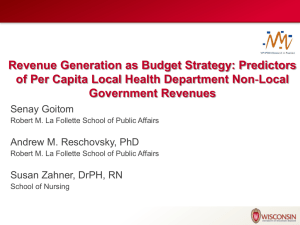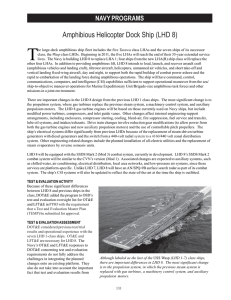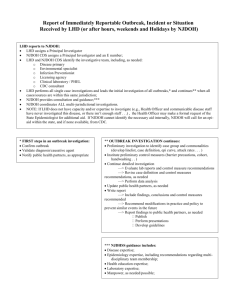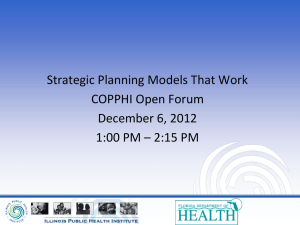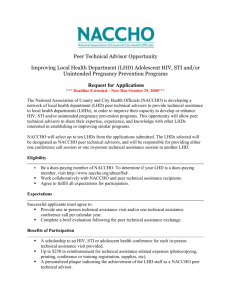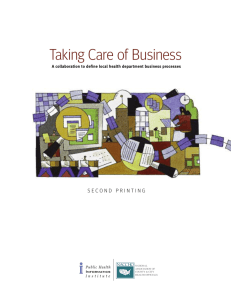Green State Performance Based Contracting
advertisement
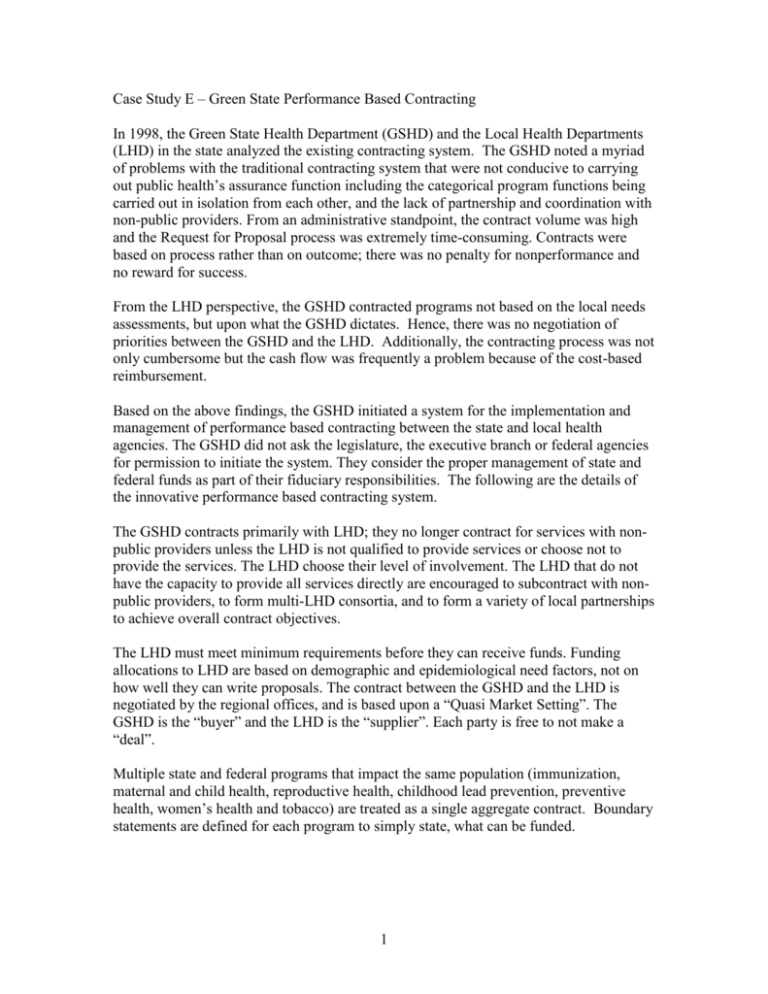
Case Study E – Green State Performance Based Contracting In 1998, the Green State Health Department (GSHD) and the Local Health Departments (LHD) in the state analyzed the existing contracting system. The GSHD noted a myriad of problems with the traditional contracting system that were not conducive to carrying out public health’s assurance function including the categorical program functions being carried out in isolation from each other, and the lack of partnership and coordination with non-public providers. From an administrative standpoint, the contract volume was high and the Request for Proposal process was extremely time-consuming. Contracts were based on process rather than on outcome; there was no penalty for nonperformance and no reward for success. From the LHD perspective, the GSHD contracted programs not based on the local needs assessments, but upon what the GSHD dictates. Hence, there was no negotiation of priorities between the GSHD and the LHD. Additionally, the contracting process was not only cumbersome but the cash flow was frequently a problem because of the cost-based reimbursement. Based on the above findings, the GSHD initiated a system for the implementation and management of performance based contracting between the state and local health agencies. The GSHD did not ask the legislature, the executive branch or federal agencies for permission to initiate the system. They consider the proper management of state and federal funds as part of their fiduciary responsibilities. The following are the details of the innovative performance based contracting system. The GSHD contracts primarily with LHD; they no longer contract for services with nonpublic providers unless the LHD is not qualified to provide services or choose not to provide the services. The LHD choose their level of involvement. The LHD that do not have the capacity to provide all services directly are encouraged to subcontract with nonpublic providers, to form multi-LHD consortia, and to form a variety of local partnerships to achieve overall contract objectives. The LHD must meet minimum requirements before they can receive funds. Funding allocations to LHD are based on demographic and epidemiological need factors, not on how well they can write proposals. The contract between the GSHD and the LHD is negotiated by the regional offices, and is based upon a “Quasi Market Setting”. The GSHD is the “buyer” and the LHD is the “supplier”. Each party is free to not make a “deal”. Multiple state and federal programs that impact the same population (immunization, maternal and child health, reproductive health, childhood lead prevention, preventive health, women’s health and tobacco) are treated as a single aggregate contract. Boundary statements are defined for each program to simply state, what can be funded. 1 Since there is a movement toward funding changes in health status (i.e. outcomes) and away from funding activities (i.e. process), program quality criteria were established as preconditions for program participation. These include: Assessment and surveillance Delivery of public health services Record keeping Information, education and outreach Coordination with related programs Referral network Provision of guidance to staff Financial management practices Data collection, analysis and reporting Specific outcome objectives are negotiated between the region and the LHD, but final approval is required by the GSHD. The Risk Profile determines the portion of the funds that will be recouped if the objective is not attained by the end of the contract year. This is negotiated taking into account the complexity and the innovation of the objective. Then a web-based Contract Information Management Systems (CIMS) is used to negotiate and, subsequently, to write the contract. Additional components of the performance based contracting system: Flexibility is given to the LHD to move funds within the contract across program boundaries to achieve negotiated program outcomes. LHD are not required to make monthly expenditure reports. Cash flow management is stabilized through 1/12th total funds monthly payment across all programs; it is not based upon the prior month’s expenditures. Year end audits focus on health-related outcomes, not fiscal accounting. Each contract objective is “mapped” to Federal 2010 objectives, GSHD priorities, core public health services and core functions. 2 Case Study E - Discussion Questions This case study describes a state health department’s effort to improve the contracting system between the state health department and the local health departments. It includes aspects of performance management in order to accomplish this end. The following questions focus on performance management issues involved in quality improvement efforts. 1. Identify the target of this performance management application. Whose or what’s performance is being improved? Describe what the performance accomplishment is in this case study. 2. Which of the four components of performance management are evident in this case study? Which are not? Does this case study demonstrate the use of performance standards? How? Does this case study demonstrate the use of performance measurement? How? Does this case study demonstrate the use of reporting performance? How? Does this case study demonstrate the use of quality improvement? How? 3. Which specific performance management components in this case study could be enhanced? How? 4. Review the system prior to the performance based contract implementation what elements of performance management did or did not exist previously? 5. Have you been (or are you now) involved in an effort to improve the contracting system between your state health department and your local health department? If so, which components of comprehensive performance management were in place? What suggestions do you have for improving that effort? 3 Case Study E - Discussion Questions: Facilitator’s Notes This case study describes a state health department’s effort to improve the contracting system between the state health department and the local health departments. It includes aspects of performance management in order to accomplish this end. The following questions focus on performance management issues involved in quality improvement efforts. 1. Identify the target of this performance management application. Whose or what’s performance is being improved? Describe what the performance accomplishment is in this case study. Answers/Discussion points: This case study focuses on improving the contracting system between the Green State Health Department and the Local Health Departments by creating performance based contracts which focus on outcomes rather than process. 2. Which of the four components of performance management are evident in this case study? Which are not? Answers/Discussion points: All four components were used in the case study. A performance management system is the continuous use of all the above practices so that they are integrated into an agency’s core operations. Performance management can be carried out at multiple levels, including the program, organization, community, and state levels. However it is applied, the performance management cycle is a tool to improve health, increase efficiency, and create other benefits and value for society. b. Does this case study demonstrate the use of performance standards? How? Answers/Discussion points: Performance standards include identifying relevant standards, selecting indicators, setting goals and targets and communicating expectations. Performance standards are objective standards or guidelines that are used to assess an organization’s performance. They may be set on national, state or scientific guidelines or be based on the public’s or leader’s expectations. In this case study, the standards are the GSHD minimum requirements in order for LHD to receive funding. Additionally, 4 each contract objective is “mapped” to Federal 2010 objectives, GSHD priorities, core public health services and core functions. Note: For additional questions refer to Section II: Performance Standards of the Performance Management Self-Assessment Tool. c. Does this case study demonstrate the use of performance measurement? How? Answers/Discussion points: Performance measurement is the refining of indicators and defining measure. Performance measures are quantitative measures of capacities, processes, or outcomes relevant to the assessment of a performance indicator. It also includes developing a data system which can collect the data based on the measures. The program quality criteria are used as the major source of performance measures. The risk profile is used as the data collection system. The risk profile determines the portion of the funds that will be recouped if the objective is not attained by the end of the contract year. Note: For additional questions refer to Section III: Performance Measurement of the Performance Management Self-Assessment Tool. d. Does this case study demonstrate the use of reporting performance? How? Answers/Discussion points: The reporting of performance component includes analyzing data, feeding data back to managers, staff, policy makers, and constituent, and developing a regular reporting cycle. The data from the risk profile is analyzed using the Contract Information Management System to write the contract. There is a year end audit focusing on the health related outcomes. A regular reporting cycle was established. Note: For additional questions refer to Section IV: Reporting of Progress of the Performance Management Self-Assessment Tool. e. Does this case study demonstrate the use of quality improvement? How? Answers/Discussion points: Quality improvement process relies on the use of data for decisions to improve policies, programs and outcomes, then manage those changes and create a learning organization. 5 Based on the data from the risk profile new contracts were established based on outcomes not processes. Funds will be recouped if objectives are not attained by the end of the contract year. Cash flow management is stabilized through 1/12th total funds monthly payment across all programs. Year end audits are based on outcomes not processes. Note: For additional questions refer to Section V: Quality Improvement Process of the Performance Management Self-Assessment Tool. 3. Which specific performance management components in this case study could be enhanced? How? Answers/Discussion points: Performance Measures – Expand on the data collection Reporting of progress – Have the LHD prepare monthly expenditure reports for the GSHD. Additional Questions to Discuss: Is there a set specific performance standards, targets, or goals? How do you determine these standards? Is there benchmark against similar state organizations or use national, state, or scientific guidelines? Is there a way to measure the capacity, process, or outcomes of established performance standards and targets? What tools do you use to assist in these efforts? Is there documentation or reporting of progress? Is this information regularly available to managers, staff, and others? Is there a quality improvement process? What do you do with the information gathered in the progress report or document? Is there a process to manage changes in policies, programs, or infrastructure that are based on performance standards, measurements, and reports? [The questions below build on the ability to identify performance management concepts and component in this case study and ask course participants to relate this case study to their own experience. It may not be possible to address these issues in case study discussions if time is limited.] 4. Review the system prior to the performance based contract implementation what elements of performance management did or did not exist previously? Answers/Discussion points: 6 There was no negotiation of priorities between the state and local health department. Additionally, the programs contracted were not based on the local needs assessments but upon what the state dictated. Hence, there was a lack of performance standards. The contract was based on process rather than on outcome, and the process itself was cumbersome, lacking any quality improvement effort. 5. Have you been (or are you now) involved in an effort to improve the contracting system between your state health department and your local health department? If so, which components of comprehensive performance management were in place? What suggestions do you have for improving that effort? Answers/Discussion points: Use the Performance Management Self-Assessment Tool to help identify all the components of the system that should be applied. 7



